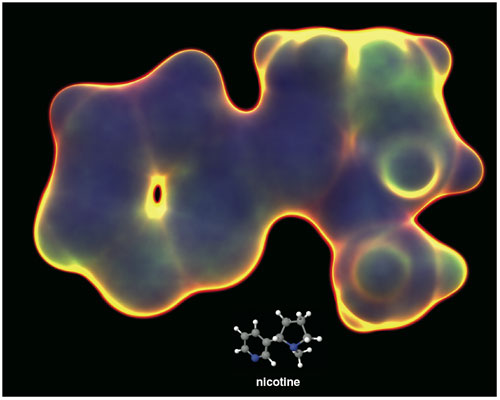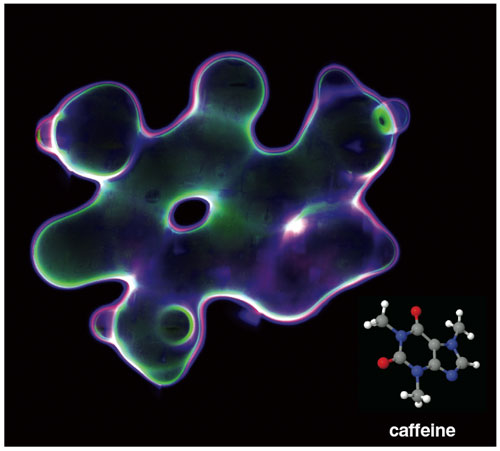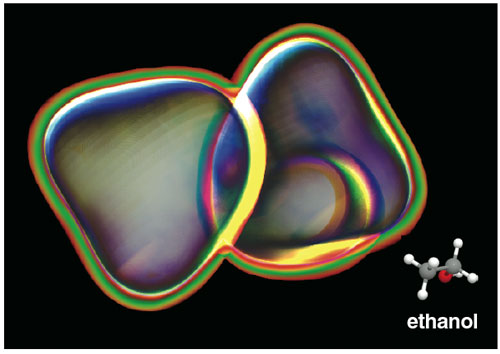Molecular Morphing
By Felice Frankel
Computer-generated ball-and-stick representations of molecular structure
Computer-generated ball-and-stick representations of molecular structure

DOI: 10.1511/2006.61.454
I couldn't believe it. There it was: a reflection of a window pane, smack dab on the surface of the ball portraying a hydrogen atom in a water molecule! Such was my introduction to computer-generated ball-and-stick representations. Astounding, I recall thinking—dead wrong and pretty silly. And why some of my influential chemist-friends never questioned that particular misinformational use of artistic license remains a puzzle. Yet some of those same chemists will probably roll their eyes as I profile here some preliminary thinking about a different approach to representing molecular structure. They will ask: Where are the data? What exactly are we seeing? What are these offering us? Why bother?
So here's my response. When I first saw a number of these preliminary representations created by computer scientists Ron Perry of Mitsubishi Electric Research Laboratories and Sarah Frisken, now at Tufts University, I was so taken with their beauty that I couldn't not look, even as I wondered about the information in the representations. True, only certain properties of molecules are represented, and, for that matter, some of the color nuances might be ambiguous. However, Ron and Sarah's next steps, described below, will address those issues and develop these into highly informational representations. I suggest that wanting to look at a scientific representation is the first step in engagement—in inspiring the thoughtful involvement scientists desperately want from the public.
I ask my chemist friends, then, to restrain their knees from jerking and to consider the potential value of establishing an aesthetic for visual thinking and representation, and using that aesthetic as a tool for understanding.

F. F. Tell us how these ideas began.
R. P. and S. F. We first rendered molecules in this form to illustrate the versatility of adaptively sampled distance fields or ADFs, the underlying shape representation used to create the images. ADFs are a unifying representation of shape that integrate numerous concepts in computer graphics, including the representation of surface and volume data and a broad range of processing operations such as rendering, sculpting and collision detection. ADFs are especially effective for quality reconstruction of complex shapes—artistic and organic forms, precision parts, volumes, high-order functions and fractals, for example. To illustrate organic forms and volumetric data, we used ADFs to represent and render the electron probability distribution of a cyclohexane molecule in an ACM SIGGRAPH publication that introduced ADFs. [SIGGRAPH is the Special Interest Group on Graphics and Interactive Techniques of the Association for Computing Machinery.]

The initial molecular renderings were so striking that we created several others for an art piece called 'Desiderata" (created by Alyn Rockwood, Thouis Jones along with us) that depicts the dichotomy between the aesthetic beauty of certain molecules, rendered this way, and their destructive, addictive qualities. Some images from "Desiderata" were published in Computer Graphics and eventually caught the eye of Carl Carlson, the director of the 2002 NOVA documentary "The Search for a Safe Cigarette." We ended up creating several animated sequences of rendered molecules for the documentary to illustrate nicotine and the formation of carcinogenic compounds from elements in tobacco.
F. F. How much of your thinking addressed real information about molecular shape?

R. P. and S. F. These renderings are geometrically accurate—we extracted the relative position and atomic radius of each atom from the Worldwide Protein Data Bank (www.wwpdb.org). The images were created using volumetric rendering where a turbulent texture was used to depict the amorphous nature of the electron probability distributions.

F. F. What is your plan now that you will be refining the representations, making them more informative?
R. P. and S. F. Sarah recently joined the Computer Science faculty at Tufts University, where she is building a research lab focused on computer graphics, physics-based modeling and scientific visualization. This summer we have begun to refine the ADF representation for molecular rendering. We are looking at incorporating additional data to identify individual atoms, different types of bonds, electrostatic charge, and properties such as locations of hydrophobic or hydrophilic regions by using local variation in color, texture and density in the renderings. We are also beginning to look at simulating interactions between molecules by exploiting the ADF representation to model intermolecular forces.
Click "American Scientist" to access home page
American Scientist Comments and Discussion
To discuss our articles or comment on them, please share them and tag American Scientist on social media platforms. Here are links to our profiles on Twitter, Facebook, and LinkedIn.
If we re-share your post, we will moderate comments/discussion following our comments policy.